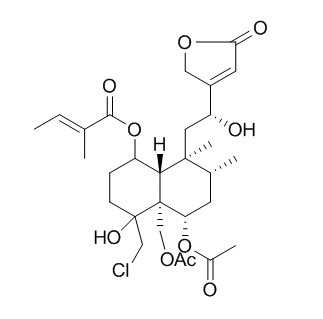Ajugamarin chlorohydrin
Reference standards.
Inquire / Order:
manager@chemfaces.com
Technical Inquiries:
service@chemfaces.com
Tel:
+86-27-84237783
Fax:
+86-27-84254680
Address:
1 Building, No. 83, CheCheng Rd., Wuhan Economic and Technological Development Zone, Wuhan, Hubei 430056, PRC
Providing storage is as stated on the product vial and the vial is kept tightly sealed, the product can be stored for up to
24 months(2-8C).
Wherever possible, you should prepare and use solutions on the same day. However, if you need to make up stock solutions in advance, we recommend that you store the solution as aliquots in tightly sealed vials at -20C. Generally, these will be useable for up to two weeks. Before use, and prior to opening the vial we recommend that you allow your product to equilibrate to room temperature for at least 1 hour.
Need more advice on solubility, usage and handling? Please email to: service@chemfaces.com
The packaging of the product may have turned upside down during transportation, resulting in the natural compounds adhering to the neck or cap of the vial. take the vial out of its packaging and gently shake to let the compounds fall to the bottom of the vial. for liquid products, centrifuge at 200-500 RPM to gather the liquid at the bottom of the vial. try to avoid loss or contamination during handling.
Nutrients.2022, 14(23):4997.
Nat Commun.2019, 10(1):2745
Appl Biol Chem2019, 62:46
Cell Death Differ.2021, 1-8.
iScience.2023, 26(9):107602.
J Med Food.2016, 19(12):1155-1165
J Chromatogr B Analyt Technol Biomed Life Sci.2019, 1124:323-330
Int J Mol Sci.2019, 20(11):E2734
Phytomedicine.2022, 96:153877.
Phytochem Anal.2022, doi: 10.1002
Related and Featured Products
CHEMICAL & PHARMACEUTICAL BULLETIN, 1983, 31(7):2192-2199.
The Chemical Constituents of Ajuga Plants. I. neo-Clerodanes from the Leaves of Ajuga nipponensis MAKINO.[Reference:
WebLink]
METHODS AND RESULTS:
Three new bitter principles, ajugamarin, dihydroajugamarin, and Ajugamarin chlorohydrin, which belong to the neo-clerodane group of diterpenoids, have been isolated from the leaves of Ajuga nipponensis. The structures of these compounds were established by chemical and spectroscopic means.
CONCLUSIONS:
The absolute structure of ajugamarin was determined by the X-ray analysis of ajugamarin p-bromobenzoate. Ajugamarin chlorohydrin may have been formed by addition of hydrogen chloride to ajugamarin during the isolation procedure.



